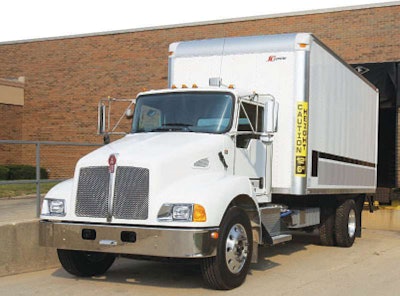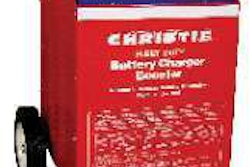Medium-duty tires log fewer miles than their linehaul counterparts, but they still face some unique challenges
Concrete jungles can be unkind to the tires on a medium-duty truck. Treads are scrubbed away with every stop and turn. Sidewalls are slashed and scuffed with each kiss of the curb. Road debris tears into any rubber it can find.
 Medium-duty trucks tend to return to a home base every night, giving technicians more opportunities
Medium-duty trucks tend to return to a home base every night, giving technicians more opportunitiesThe right features can mean the difference between a tire that lasts – and one that takes a premature trip to the scrap pile.
A key line of defense on many medium-duty designs is provided by an extra layer of material on the sidewall. As these protective layers begin to wear away, the tires can be rotated to other positions, exposing the untouched layer on the wheel’s other side.
The extra layer of rubber may not include the wear indicators found on bus tire sidewalls, but a quick look will identify when it is disappearing.
But some tire features should be avoided altogether. Greg McDonald, Bridgestone’s engineering manager, national accounts – commercial products, cautions against designs that include the “defense grooves” that promise to reduce shoulder wear. These channels that are cut around the tire’s circumference will tear apart quickly in an urban application.
“They are going to want to have a solid-shoulder tire,” says McDonald, who also recommends products with a limited number of sipes. The tiny cuts may help increase traction in some applications, but they also present natural spots where the rubber can begin to tear.
Tread talk
The tread enhancements are not limited to the tire’s profile; it also is important to find a tread compound that is formulated to protect against excess scrubbing. “The main thing you want to look for is even, smooth wear down to the final tread depth,” says Gary Enterline, product category manager for Michelin North America.
Medium-duty treads may be less likely than longhaul treads to show signs of irregular wear, but the issue still can emerge. If a truck takes an unusually large number of turns, mechanics may spot a tapered wear pattern that traditionally would suggest problems with toe settings. A heel-to-toe wear on the lugs of a utility truck’s deep treads also may be caused by the torque generated as the vehicle pulls on and off the road.
One solution to these issues is better route planning. One package delivery company faces extra wear on the left shoulder of its tires because it virtually has eliminated left-hand turns in a bid to reduce the need to cross traffic. “Rotation will counteract that for a good degree as well, but it’s still something they have to know why it is happening,” McDonald says.
A number of mechanical issues also can lead to tire challenges. Tim Miller, Goodyear’s marketing-communications manager for commercial tires, points out how alignments can be thrown off by the jarring forces of potholes and curbs in an urban setting. “If axles are not kept within alignment specs, various types of fast wear and shoulder wear conditions can always occur,” Miller says.
Alignment checks also should search for any underlying factors. A truck that wanders in its lane could have a problem with wheel bearings, kingpins, tie rod ends or shock absorbers, McDonald adds. If drivers are reporting vibrations, mechanics might want to check for damaged tires or rebalance the wheels.
Retread rules
Once treads wear away, medium-duty designs also are ideal candidates for retreading programs, offering tires that can cost about one-third the price of a newly manufactured product.
For a program like this to be successful, however, fleets should ask a few key questions. “Does the retread provider offer tread patterns that are similar to or exactly like the new tires you have chosen to run?” Miller asks. “Does the retreader have the ability to have you check online for the status of your casings that are in the process of retreading? Does the retreader offer other online tools that can help you manage your new tires, casings and retreads?”
A buyer’s ultimate choice likely will come down to his business model.
But when asked about the leading maintenance strategy in any tire program, most experts focus on the need to monitor and maintain recommended inflation pressures.
Medium-duty fleets should be in a great position to watch over tire pressures. Their trucks tend to return to a home base every night, giving technicians more opportunities to attach tire gauges on the valve stems. But linehaul tires may be enjoying more attention. Data extracted from TVTrack – Goodyear’s Web-based tire performance tracking system – shows that 10 percent of the tires typically used for pickup-and-delivery operations are underinflated. Only 6.7 percent of the linehaul tires are underinflated.
“Too often, tire inflation pressure is neglected, and the result is a failed tire and the downtime and cost associated with it,” Miller says.
Technology such as tire pressure monitoring systems can help. Designs already are incorporating more features and benefits than ever and the equipment already is mandated on cars and light trucks. Can medium-duty designs and heavy trucks be far behind?
Regulatory matters
The impact of regulations hardly ends there. Tires are expected to play a role in the enhanced fuel efficiency standards recently introduced by the Environmental Protection Agency and National Highway Traffic Safety Administration. “The OEMs are obviously going to be asking us about low-rolling-resistance tires,” Enterline says. “The OEMs will get it started, and we’re going to see more of it in the replacement market coming down the road.”
 Medium-duty treads such as Michelin’s XD2 may be less likely than their longhaul counterparts to show signs of irregular wear, but the issue still can emerge.
Medium-duty treads such as Michelin’s XD2 may be less likely than their longhaul counterparts to show signs of irregular wear, but the issue still can emerge.
Equipment like utility trucks likely will have little use for the reduced rolling effort, especially when they need tires to pull on and off the road. They also would be unlikely to experience any gains in fuel economy at the best of times. A utility truck driver may travel a mere 25 miles before arriving on a jobsite, putting down the outriggers and engaging the cherry picker, says Bert Jones, manager of product marketing for Bridgestone Commercial Solutions. The biggest fuel savings here will come from
anti-idling strategies.
But some medium-duty fleets will be interested in the possibilities. Miller refers to regional carriers that make a limited number of stops during a trip; Enterline points to fleets already embracing hybrid delivery trucks and suggests they will be eager for anything that promises to enhance fuel economy even more.
A buyer’s ultimate choice likely will come down to his business model. “There’s going to still be some people that have a very hard time ‘value-izing’ the fuel economy,” says Enterline, noting how some companies focus on the cost per mile rather than the overall total cost of ownership, which would consider factors like diesel savings.
No matter the business model, tire choices always will play a role in profitability.










